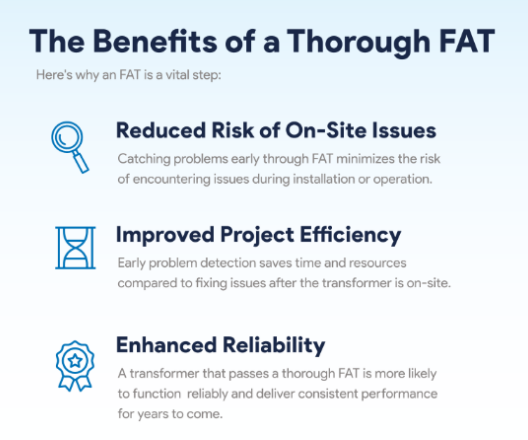We are excited to share that our 2.5MVA Enhanced Fire Protection Transformers have successfully finished assembly and passed Factory Acceptance Testing (FAT)!
This Battery Energy Storage System (BESS) in Australia stores energy for later use, helping to balance electricity supply and demand. They support renewable energy sources, provide backup power during outages, and enhance the reliability of the electrical grid.

When it comes to ensuring the performance, reliability, and safety of electrical transformers, Factory Acceptance Testing (FAT) plays a pivotal role. It is a critical process that verifies the design, construction, and operational readiness of a transformer before it is delivered to the customer or installed in its intended location. This testing is not just a routine procedure but an essential step to instill confidence and ensure the product meets all specified requirements.
Factory Acceptance Testing (FAT) is a series of rigorous tests and inspections conducted on electrical transformers at the manufacturing facility before they are shipped to the customer. This process aims to validate the design specifications, confirm operational integrity, and ensure compliance with regulatory and contractual requirements.
FAT typically includes both functional and performance tests, verifying that the transformer can operate under expected conditions. The scope of the testing is determined by customer requirements, industry standards, and the type of transformer being evaluated.
Factory Acceptance Testing serves as a quality assurance gateway, ensuring that transformers meet all technical and functional specifications before they leave the factory. Here's why it is crucial:
The FAT process involves several key stages designed to assess the transformer’s readiness for deployment:
Conducting a comprehensive FAT process offers numerous advantages:

Factory Acceptance Test Protocol
written plan is created that outlines customer specifications, applicable standards, and relevant drawings. By clearly identifying the scope of the FAT, the manufacturer ensures the equipment meets acceptable quality standards and reliability expectations. This plan is shared with the customer early on to confirm it aligns with their needs and specifications.
Before the FAT begins, a complete set of reference materials is compiled, including:
During the FAT, the following activities are undertaken:
By following these three stages, the FAT Protocol ensures a well-organized, documented, and thorough testing process. This approach confirms the functionality and quality of industrial equipment or systems before delivery to the customer.
While FAT is critical, it is not without challenges. Common obstacles include:
Scheduling Conflicts: Coordinating with customer representatives can delay testing.
Resource Limitations: Lack of specialized equipment or skilled personnel may hinder testing.
Complex Specifications: Custom designs may require tailored test protocols.
At Varelen, we prioritize excellence in every stage of transformer manufacturing, including FAT. Our process includes:
By adhering to rigorous FAT protocols, Varelen delivers transformers that exceed expectations in quality, performance, and reliability.
Factory Acceptance Testing (FAT) is a cornerstone in the production of high-quality transformers, offering an essential layer of assurance to manufacturers and customers alike. From verifying operational readiness to ensuring compliance with industry standards, FAT is indispensable for achieving optimal transformer performance and reliability.
Whether it’s the precise functionality of an earthing transformer or the robust testing processes at Varelen, FAT serves as a bridge between design intent and operational reality. By investing in thorough FAT practices, manufacturers and clients can safeguard against risks, reduce costs, and extend the lifespan of their equipment—delivering value that lasts for decades.